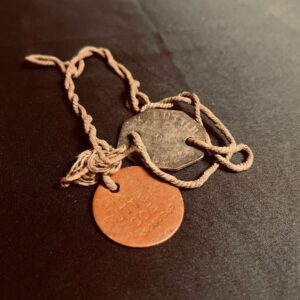Forgotten Friday – The History of Military Dog Tags.
Its Friday! Which means its #ForgottenFriday.. Today we are delving into the history of dog tags! Did you know… The idea of an embalming tag was proven to be the reason dog tags were invented? Read more below to find out…
The history of these interesting artefacts dates to the American Civil war in the 1860s. This was because the need for identification became heavily apparent. Fallen soldiers were identified by their name and address written on slips of paper and pinned to their clothing.
At this time embalming had been taking place and soldiers who died many miles away from home, could have their bodies preserved and shipped back to their family for burial. Before the Union army began to offer this service, an insurance policy could be purchased to have this procedure carried out should a soldier be killed on the battlefield. To identify the soldier, a tag was issued with your policy number inscribed upon it and worn around their neck. Once your body was found on the battlefield with this disk, their bodies would be removed and taken to the rear where there were embalming sheds. There their bodies would be treated accordingly and shipped home in a zinc lined coffin.
It was not until 1907 when the first British ‘Disk’ Identity was introduced by Army Order Number 9. This order stated that an aluminium disk would be hung from a piece of cord. The information stamped onto the disk would be the soldier’s number, name, regiment, and religious denomination.
When WWI broke out in August 1914, the army naturally began to expand in size and it became very apparent that keeping up with the supply of the aluminium disks, as well as the expense, would be a problem. So, on 21st August a new disk, would come into service.
There were two disks to be worn; one was red/brown and the other was green (see our photo below!) and were approximately the same size as the original aluminium disk. Both were made out vulcanised asbestos fibre and were stamped with the same details as before. In the event that a soldier was killed, the red tag was removed from the body and the green tag left with the body.

Dog Tags – Belonging to H Rutter, 11263240
Unfortunately, many of the soldiers of the Great War never went to the trouble of having personal ID bracelets made or fashioned either. Consequently, these soldiers have never been identified as their army issued tags have simply rotted away in the soil of the Western Front. Therefore, there is a lot of soldiers remains being excavated to this day.
To read more about the history of the dog tag there is information here – https://www.riflemantours.co.uk/history-of-military-dog-tags/ (c) Rifleman Tours.

